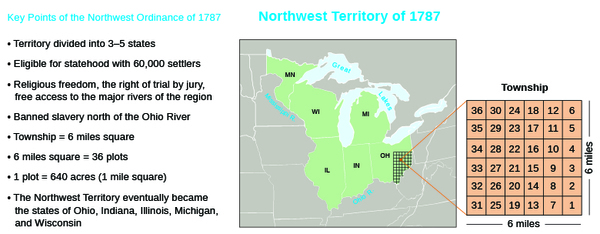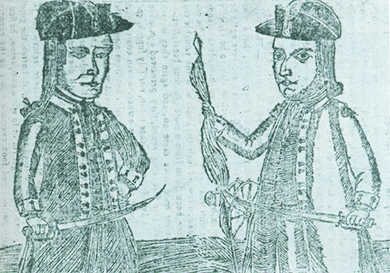| << Chapter < Page | Chapter >> Page > |

Visit Window Seat to explore aerial views of the grid system established by the Northwest Ordinance of 1787, which is still evident in much of the Midwest.
The land ordinances proved to be the great triumph of the Confederation Congress. The Congress would appoint a governor for the territories, and when the population in the territory reached five thousand free adult settlers, those citizens could create their own legislature and begin the process of moving toward statehood. When the population reached sixty thousand, the territory could become a new state.
Despite Congress’s victory in creating an orderly process for organizing new states and territories, land sales failed to produce the revenue necessary to deal with the dire economic problems facing the new country in the 1780s. Each state had issued large amounts of paper money and, in the aftermath of the Revolution, widespread internal devaluation of that currency occurred as many lost confidence in the value of state paper money and the Continental dollar. A period of extreme inflation set in. Added to this dilemma was American citizens’ lack of specie (gold and silver currency) to conduct routine business. Meanwhile, demobilized soldiers, many of whom had spent their formative years fighting rather than learning a peacetime trade, searched desperately for work.
The economic crisis came to a head in 1786 and 1787 in western Massachusetts, where farmers were in a difficult position: they faced high taxes and debts, which they found nearly impossible to pay with the worthless state and Continental paper money. For several years after the peace in 1783, these indebted citizens had petitioned the state legislature for redress. Many were veterans of the Revolutionary War who had returned to their farms and families after the fighting ended and now faced losing their homes.
Their petitions to the state legislature raised economic and political issues for citizens of the new state. How could people pay their debts and state taxes when paper money proved unstable? Why was the state government located in Boston, the center of the merchant elite? Why did the 1780 Massachusetts constitution cater to the interests of the wealthy? To the indebted farmers, the situation in the 1780s seemed hauntingly familiar; the revolutionaries had routed the British, but a new form of seemingly corrupt and self-serving government had replaced them.
In 1786, when the state legislature again refused to address the petitioners’ requests, Massachusetts citizens took up arms and closed courthouses across the state to prevent foreclosure (seizure of land in lieu of overdue loan payments) on farms in debt. The farmers wanted their debts forgiven, and they demanded that the 1780 constitution be revised to address citizens beyond the wealthy elite who could serve in the legislature.
Many of the rebels were veterans of the war for independence, including Captain Daniel Shays from Pelham ( [link] ). Although Shays was only one of many former officers in the Continental Army who took part in the revolt, authorities in Boston singled him out as a ringleader, and the uprising became known as Shays’ Rebellion. The Massachusetts legislature responded to the closing of the courthouses with a flurry of legislation, much of it designed to punish the rebels. The government offered the rebels clemency if they took an oath of allegiance. Otherwise, local officials were empowered to use deadly force against them without fear of prosecution. Rebels would lose their property, and if any militiamen refused to defend the state, they would be executed.

Despite these measures, the rebellion continued. To address the uprising, Governor James Bowdoin raised a private army of forty-four hundred men, funded by wealthy Boston merchants, without the approval of the legislature. The climax of Shays’ Rebellion came in January 1787, when the rebels attempted to seize the federal armory in Springfield, Massachusetts. A force loyal to the state defeated them there, although the rebellion continued into February.
Shays’ Rebellion resulted in eighteen deaths overall, but the uprising had lasting effects. To men of property, mostly conservative Whigs, Shays’ Rebellion strongly suggested the republic was falling into anarchy and chaos. The other twelve states had faced similar economic and political difficulties, and continuing problems seemed to indicate that on a national level, a democratic impulse was driving the population. Shays’ Rebellion convinced George Washington to come out of retirement and lead the convention called for by Alexander Hamilton to amend the Articles of Confederation in order to deal with insurgencies like the one in Massachusetts and provide greater stability in the United States.
The late 1770s and 1780s witnessed one of the most creative political eras as each state drafted its own constitution. The Articles of Confederation, a weak national league among the states, reflected the dominant view that power should be located in the states and not in a national government. However, neither the state governments nor the Confederation government could solve the enormous economic problems resulting from the long and costly Revolutionary War. The economic crisis led to Shays’ Rebellion by residents of western Massachusetts, and to the decision to revise the Confederation government.

Notification Switch
Would you like to follow the 'U.s. history' conversation and receive update notifications?